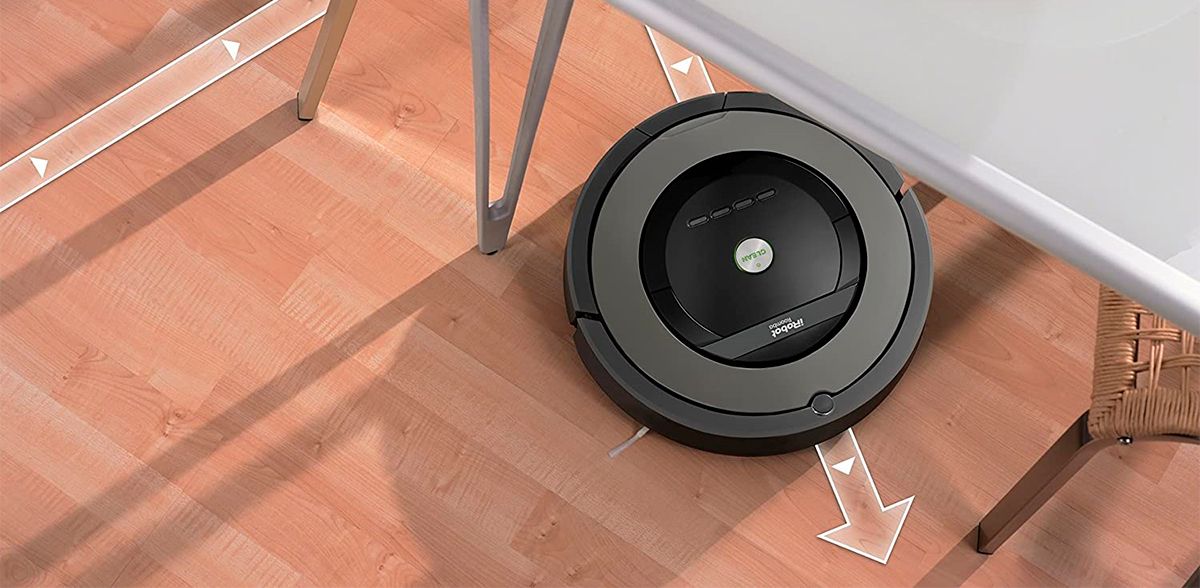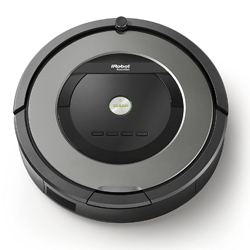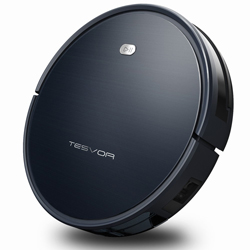iRobot Roomba 877: AeroForce Enabled

The iRobot Roomba 877 review focuses on the ability of this vacuum cleaner to guarantee efficient cleaning power for your home. It holds a vast cleaning capability, ranging from small pieces of debris to minuscule strands of hair and allergens. Also, the presence of retractable canisters and brushes makes it easier to retain its reusability over a long period. The Roomba 877 has a long life-span and does not take long to recharge after one use. For houses with a lot of furniture, the vacuum cleaner can detect obstacles and avoid colliding with them while cleaning the house. The iRobot 877 can clean floors of all types and textures with the same level of efficiency.
Dimensions
The specific dimensions of the Roomba 877 are as follows:
- Height — 19.40 in
- Width —17.00 in (circumference)
- Depth — 6.10 in
The cleaning device weighs 12.1lbs. The three-blade brush at the edge is located at a 27° angle towards the floor. The robot can cover an area of 1000 square feet within 1 hour. The noise level during cleaning does not exceed 60 dB. The suction power of the Roomba robot is around 1000 PA, which makes it suitable for homes with pets and kids. The dustbin capacity is 300ml, which helps in reducing the number of times you have to clear the bin in a week.
Features
During this iRobot 877 review, I found out that the vacuuming device makes use of a lithium-ion battery that makes it possible to recharge and use over a prolonged period. The battery takes a minimum of 3 hours to recharge to full capacity.
The tangle-reduction brush-rolls at the bottom make use of the AeroForce solution to eliminate the risk of hair, particles, allergens, pollen, and fluff of sizes as small as 10 microns from sticking between the bristles of the brush-rolls, making them less efficient and difficult to clean. Also, the AeroForce cleaning system makes use of the three-step cleaning method: loosen, lift, and suction to clean the house.
The triple-blade brush makes use of the 27-degree inversion towards the floor to generate a centripetal force that helps suck in dirt and debris towards the direction of the brush-rolls. The Roomba 877 triple-blade brush system also extends beyond the circumference of the cleaner. This feature helps the brush clean corners in the house without any collision.
The iRobot Roomba 877 also comes with the Virtual Wall/Lighthouse Beacon, which helps in navigating between rooms inside the house. These sensors enable this ‘robovac’ to avoid obstacles and clean beneath furniture and edges without scratching the surface.
The docking system serves as a reference point for the cleaning robot. You do not have to retrieve the Roomba 877 because it will automatically return to the dock when the battery should be recharged.
You can schedule your cleaning with the controls on the top panel. The schedule can be reused every day of the week. Also, you can set the navigation path to optimize the cleaning time.
The low height helps the iRobot to clean under furniture and fit into narrow crevices of around 4” anywhere in the house.
The robot cleaner adapts easily to your home by automatically detecting the walls and obstacles over time.
Design
The iRobot-Roomba 877 comes in a circular/cylindrical shape that looks like a flat drum. The wheels beneath the robot enable unabated spatial navigation along the floor of the home. The color of the robot cleaner is gray. Also, the top panel contains the large ‘CLEAN’ button that starts the cleaning process. Other buttons on the panel include:
- DOCK — to return the vacuum cleaner to the dock
- CLOCK — to set a timer
- SCHEDULE — to schedule the daily cleaning time
- SPOT — to focus the cleaning on a particular spot.
The bottom panel contains the three-blade brush, the two brush-rolls, the canister that holds the filters, and the spool wheel to which the strands of hair and thread tangle.
Conclusion
The Roomba 877 is a very effective vacuum cleaner because it reduces the stress of manually moving the cleaning device from one part of the room to another. The iRobot machine makes use of an efficient power source while reducing the necessity of returning the device to the dock manually. Moreover, the two brush-rolls work in tandem to make sure that the dirt in your home comes off easily. Ultimately, the design of the iRobot Roomba 877 makes it possible to clean the parts of the house that are often neglected.

